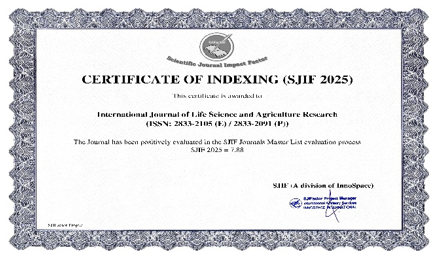Dry Land and Mountains Management Study in the Aesesa Flores River Flow Area, East Nusa Tenggara
DOI:
https://doi.org/10.55677/ijlsar/V03I7Y2024-18Keywords:
Dry_Land, Mountain_Management, River_Flow_Area, Aesesa_FloresAbstract
Aesesa Flores (AF) River Flow Area (RFA) is a natural landscape. Its headquarters are in Bajawa, Ngada Regency, and its remnants are in Nagekeo Regency. The peaks of the mountains hold rainwater and flow it naturally into the sea through the rivers. The land area concerned is the water capture area. This ecosystem consists of natural resources (land, water, and vegetation) and human resources that exploit natural and artificial resources. The state of RFA will be of great in the planning and policy of sustainable AF management. The aim of this study is to find out the level of vulnerability of dry land resources. The study will give special attention to the area of the AF river stream, the biophysical picture of dry ground in the river flow area, the vegetation, the water system of Aeseza Flores, and the role of dryland agriculture and hills in food production. The method used in this study is a library approach. The results show that the soil type in the RFA Aesesa Flores includes five soil types: aluvial, grumosol, latosol, and mediterranean. Aesesa Flores is categorized into five critical level of land, i.e., rather critical, critical potential, critical, highly critical, and non-critical. The level of density of the river intersection in a RFA and Sub-RFA region indicates the level of contribution of the RFA to the threat of flooding that may arise if the regional balance is disturbed. In the northern part of Nagekeo district, the river level is higher on steep land.
References
Abdurachman, A., A.Dariah and A.Mulyani (2008) “Dry Land Management Strategies and Technologies Supporting National Food Procurement”. Agriculture Journals.
Abbas, B., Darma., and M. Dailami (2019) “Agriculture Systems in Ecosystem Perspective”. Monokwari: Postgraduate Program of the University of Papua.
Asdak, Chay. (2010). Hydrology and Management of River Water Stream Region: Fifth Revision Edition. Yogyakarta: Gadjah Mada University Press Yogyakarta.
Barus, A. and Syukri. 2008. Agroecology of Fruit Plants. USU Press.Medan.
BPDAS Benain Noelmina. (2013). Integrated RFA management plan of RFA Aesesa province of NTT. Kupang: BPDAS Benain noelmina
Gain, A. K., Giupponi, C., and Renaud, F. G. (2012). Cl ima t e chan g e adapt a tio n a nd vulnerability assessment of water resources systems in developing countries: a generalized framework and a feasibility study in Bangladesh. Water, 4(2), 345-366; doi:10.3390/w4020345.
Idjudin, A., & Marwanto, S. (2008). Dry Land Management Reforms to Support Food Base, 2(2), 115–125.
IPCC. (2007). Summary for policy makers:Impacts, adaptation and vulnerability. Contribution of Working Group II to the Fourth Intergovernmental Panel on Climate Change. In Parry, M.L. Canziani, O.F., Palukof, J.P., van der Linden, P.J., and Hanson, C.E. (Eds). Cambridge: Cambridge University
Kasryno, F and Hayono, S (2008) “Dry Land Farming as a Solution to Achieving Future Food Independence”. Agriculture Journals.
Kasryno, F and Hayono, S (2008) “Dry Land Farming as a Solution to Achieving Future Food Independence”. Agriculture Journals, pp. 11-33.
Kenneth, N. B and M’Hammed, T (2002) “Planning and Manging Soil and Water Resources in Drylands: Role of Watershed Management”. St.Paul: University of Minnesota.
Noywuli N, Rachman LM, Sapei A, Knight H. (2017) “The Prerequisites for the Preparation of the Integrated Management Policy and Continuation of RFA Aesesa Flores Province NTT. Prosiding of the National Seminar on Integrated River Flow Area Management (RFA). UNRI LPP.
Pujiono, E. & Setyowati, R., (2015). Assessment of Water Resource Vulnerability to Climate Variability in RFA Aesesa, Flores Island, East Nusa Tenggara. Journal of Social and Forestry Economic Research, XII(3), pp. 177-195.
Syam. A. (2003). Effectiveness of Organic and Inorganic Fertilizers on Padi Productivity in the Land. Agrivigor Journal. 3(3) : 232-244.
Swandayani, T.H. (2010). Mapping the vulnerability of communities to climate change and adaptation based on forest ecosystems (RFA Ciliwung case study).
TERI [The Energy and Resources Institute]. (2009). Climate change and water vulnerability: strategies and practices for emerging water management and governance challenges - executive summary. The Energy and Resources Institute TERI in collaboration with Yale University to be released duringthe15th Conferenceof Parties tothe United Nations Framework Convention on Climate Change UNFCCC, 7–18 December 2009, Copenhagen, Denmark.
Downloads
Published
Issue
Section
License
Copyright (c) 2024 International Journal of Life Science and Agriculture Research

This work is licensed under a Creative Commons Attribution 4.0 International License.












